Related Research Articles

Baba ghanoush, also spelled baba ganoush or baba ghanouj, is a Levantine appetizer consisting of finely chopped roasted eggplant, olive oil, lemon juice, various seasonings, and tahini. The eggplant is traditionally roasted, baked or broiled over an open flame before peeling, so that the pulp is soft and has a smoky taste. It is a typical meze (starter) of the regional cuisine, often served as a side to a main meal and as a dip for pita bread.

The Maule Region is one of Chile's 16 first order administrative divisions. Its capital is Talca. The region derives its name from the Maule River which, running westward from the Andes, bisects the region and spans a basin of about 20,600 km2. The Maule river is of considerable historic interest because, among other reasons, it marked the southern limits of the Inca Empire.

Raita is a side dish in Indian cuisine made of dahi together with raw or cooked vegetables, fruit, or in the case of boondi raita, with fried droplets of batter made from besan.

The cuisine of the Southwestern United States is food styled after the rustic cooking of the Southwestern United States. It comprises a fusion of recipes for things that might have been eaten by Spanish colonial settlers, cowboys, Mountain men, Native Americans, and Mexicans throughout the post-Columbian era; there is, however, a great diversity in this kind of cuisine throughout the Southwestern states.

A pig pickin' is a type of party or gathering held primarily in the American South which involves the barbecuing of a whole hog. Females, or gilts, are used as well. Boars and sows generally are too large.
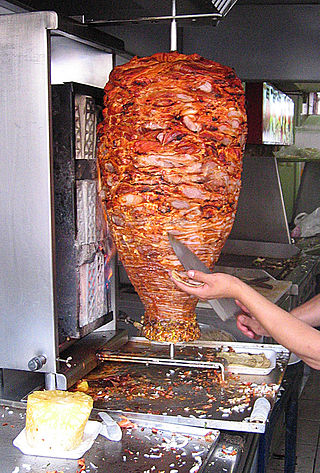
Al pastor, tacos al pastor, or tacos de trompo is a preparation of spit-grilled slices of pork originating in the Central Mexican region of Puebla and Mexico City, although today it is a common menu item found in taquerías throughout Mexico but most prominently is from these two parts of the country, where it is largely found. The method of preparing and cooking al pastor is based on the lamb shawarma brought by Lebanese immigrants to the region. Al pastor features a flavor palette that uses traditional Mexican adobada (marinade). It is a popular street food that has spread to the United States. In some places of northern Mexico and coastal Mexico, such as in Baja California, taco al pastor is known as taco de trompo or taco de adobada.

Char siu is a Cantonese-style barbecued pork. Originating in Guangdong, it is eaten with rice, used as an ingredient for noodle dishes or in stir fries, and as a filling for cha siu bao or pineapple buns. Five-spice powder is the primary spice, honey or other sweeteners are used as a glaze, and the characteristic red color comes from the red yeast rice when made traditionally.

Rajas con crema is the name given to a Mexican dish consisting of sliced poblano pepper with cream. It is very popular in Mexico, particularly in the central and southern parts of the country. It is one of the dishes most commonly served during taquizas, together with tinga, mole, chicharrón, and papas con chorizo. Preparation of the dish involves roasting, peeling and slicing the peppers, sauteing them together with sliced onions, and simmering the mixture with cream. Sometimes chicken broth is added for flavor.

An earth oven, ground oven or cooking pit is one of the simplest and most ancient cooking structures. The earliest known earth oven was discovered in Central Europe and dated to 29,000 BC. At its most basic, an earth oven is a pit in the ground used to trap heat and bake, smoke, or steam food. Earth ovens have been used in many places and cultures in the past, and the presence of such cooking pits is a key sign of human settlement often sought by archaeologists. Earth ovens remain a common tool for cooking large quantities of food where no equipment is available. They have been used in various civilizations around the world and are still commonly found in the Pacific region to date.

Peanut sauce, satay sauce, bumbu kacang, sambal kacang, or pecel is an Indonesian sauce made from ground roasted or fried peanuts, widely used in Indonesian cuisine and many other dishes throughout the world.
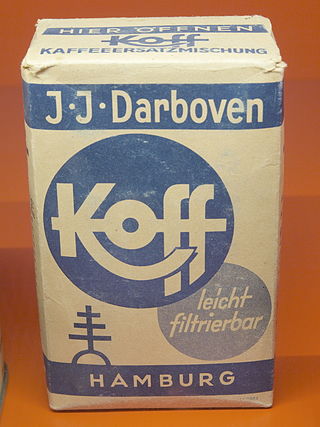
Coffee substitutes are non-coffee products, usually without caffeine, that are used to imitate coffee. Coffee substitutes can be used for medical, economic and religious reasons, or simply because coffee is not readily available. Roasted grain beverages are common substitutes for coffee.
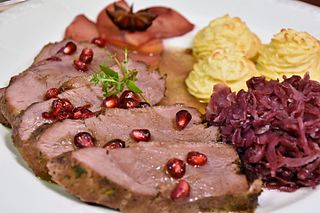
Roast goose is cooking goose meat using dry heat with hot air enveloping it evenly on all sides. Many varieties of roast goose appear in cuisines around the world, including Cantonese, European, and Middle Eastern cuisines. Roasting can enhance its flavor.

Quzi, also spelled as qoozi or ghoozi, is a popular rice-based dish and is considered one of Iraq's national dishes. It is served with very slowly cooked lamb, roasted nuts, and raisins served over rice. The dish was introduced into Turkey by Syrian immigrants. The dish can also be found in some Arab states of the Persian Gulf.
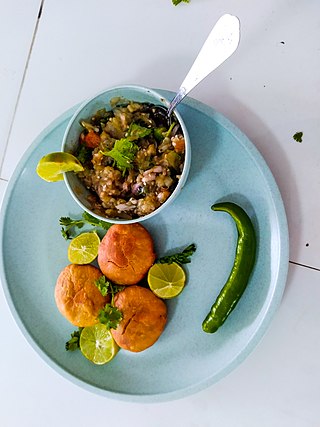
Litti is a whole wheat flour dough ball stuffed with a spiced mixture of sattu. Litti, along with chokha, is a complete meal that originated from the Bhojpuri region of the Indian states of Bihar and Uttar Pradesh. It is also a popular street food in small towns and cities. Over the years it has gained international recognition.

Manipuri cuisine refers to the cuisine of Manipur, a state of northeastern India. Daily meals are based on rice, with a few side dishes of vegetables, fish and meat. A meal would usually have a vegetable stew called ensaang or athongba, flavored with dried or fried fish; stir-fried vegetables called kanghou; and a spicy item, which could be morok metpa, eromba, or singju. All piquant side dishes are accompanied by a choice of fresh herbs, collectively called maroi. The base and essence of Meitei cuisine is the fermented fish called ngari. Several dishes of meat, mostly chicken and pork, are cooked with unique recipes. As a result of religious taboos, however, the Meitei Pangals do not cook the latter.
The Guadeloupe Bonifieur is a variety of coffee grown in Guadeloupe. Guadeloupe Bonifieur is the ancestor of Jamaican Blue Mountain Coffee and is very rare. The fresh air, high altitude, and abundance of rain create ideal conditions for growing this Arabica variety. The variety is called Guadeloupe Bonifieur because of its high quality and great taste, and because, in the past, it was used to enhance lower quality blends. Connoisseurs consider it one of the best coffees in the world, even though it is only available from a few distributors.

Dabeli, kutchi dabeli or double roti, is a popular snack food of India, originating in the Mandvi-Kutch, Gujarat region. It is a spicy yet sweet snack made by mixing boiled potatoes with a special dabeli masala, putting the mixture in a ladi pav, and serving it with chutneys made from tamarind, date, garlic, red chilies and other ingredients. It is garnished with pomegranate and roasted peanuts.

Nam phrik is a type of Thai spicy chili sauce typical of Thai cuisine. Usual ingredients for nam phrik type sauces are fresh or dry chilies, garlic, shallots, lime juice and often some kind of fish or shrimp paste. In the traditional way of preparing these sauces, the ingredients are pounded together using a mortar and pestle, with either salt or fish sauce added to taste.
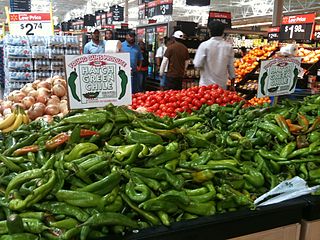
New Mexico chile or New Mexican chile is a cultivar group of the chile pepper from the US state of New Mexico, first grown by Pueblo and Hispano communities throughout Santa Fe de Nuevo México. These landrace chile plants were used to develop the modern New Mexico chile peppers by horticulturist Fabián García and his students, including Roy Nakayama, at what is now New Mexico State University in 1894.
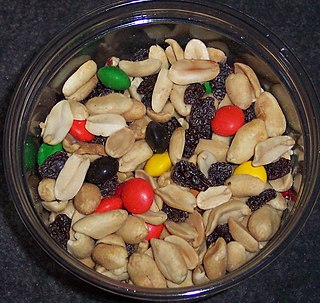
A snack is a small portion of food generally eaten between meals. A snack is often less than 200 calories, but this can vary. Snacks come in a variety of forms including packaged snack foods and other processed foods, as well as items made from fresh ingredients at home.